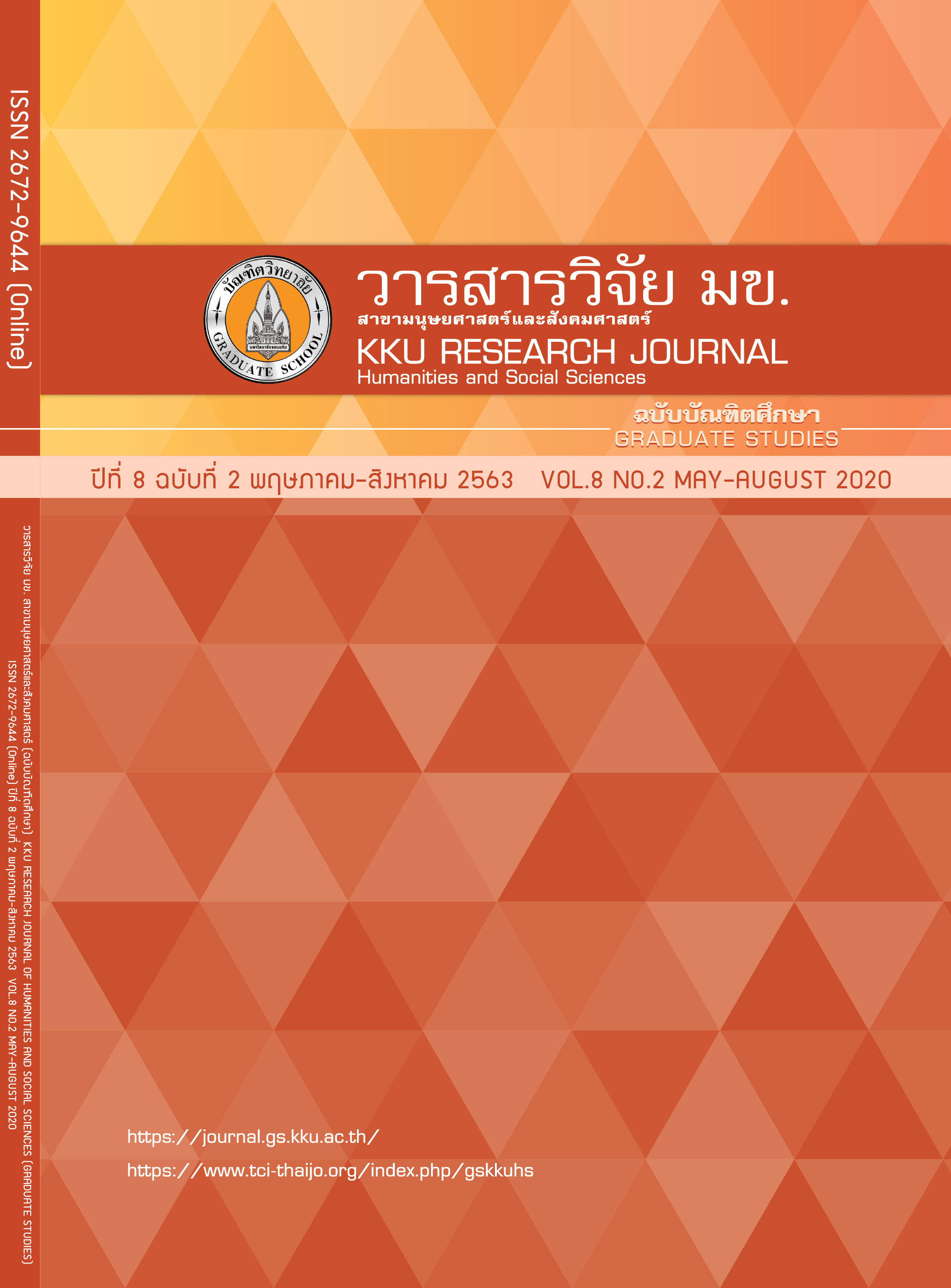การพัฒนาองค์ประกอบของอารมณ์ที่เกี่ยวเนื่องทางสังคมที่เกี่ยวข้องกับ พฤติกรรมการบริโภคของนักศึกษา
คำสำคัญ:
อารมณ์ที่เกี่ยวเนื่องทางสังคม, พฤติกรรมการบริโภคของนักศึกษา, การวิเคราะห์องค์ประกอบบทคัดย่อ
การวิจัยนี้มีวัตถุประสงค์เพื่อพัฒนาองค์ประกอบของอารมณ์ที่เกี่ยวเนื่องทางสังคมที่เกี่ยวข้องกับพฤติกรรมการบริโภคของนักศึกษา กลุ่มตัวอย่างแบ่งออกเป็น 2 กลุ่ม ดังนี้ กลุ่มที่ใช้วิเคราะห์องค์ประกอบเชิงสำรวจ คือ นักศึกษาระดับปริญญาตรี มหาวิทยาลัยอุดมศึกษาในประเทศไทย จำนวน 1,200 คน และกลุ่มที่ใช้วิเคราะห์องค์ประกอบเชิงยืนยันจำนวน 1,480 คน โดยการสุ่มแบบหลายขั้นตอน เครื่องมือที่ใช้ในการวิจัย คือ แบบสอบถามอารมณ์ที่เกี่ยวเนื่องทางสังคมที่เกี่ยวข้องกับพฤติกรรมการบริโภค วิเคราะห์องค์ประกอบเชิงสำรวจ ด้วยวิธีวิเคราะห์องค์ประกอบหลัก และใช้วิธีการหมุนแกนแบบออโธกอนอลด้วยวิธีแวริแมกซ์ ผลการวิจัยพบว่า อารมณ์ที่เกี่ยวเนื่องทางสังคมที่เกี่ยวข้องกับพฤติกรรมการบริโภค ประกอบด้วย 5 องค์ประกอบ ได้แก่ 1) การประเมินทางอารมณ์
2) จิตสำนึกทางสังคม 3) การรับรู้เชิงสัญลักษณ์ 4) คุณค่าในสายตาผู้อื่น และ 5) การรับรู้บทบาททางสังคม โมเดลการวิเคราะห์มีความสอดคล้องกับข้อมูลเชิงประจักษ์ พิจารณาจาก ค่าไค-สแควร์ เท่ากับ 1516.20, df = 898, ดัชนี GFI=0.956 ดัชนี AGFI=0.952 และดัชนี RMSEA=0.022
เอกสารอ้างอิง
Boston: Pearson; 2005.
2. Tracy JL, Robins RW. Self-conscious emotions: where self
and emotion meet. In: Sedikides C, Spencer SJ, editors.
The self. New York: Psychology Press; 2007. p. 187-209.
3. Hareli S, Parkinson B. What’s social about social emotions?
J Theory Soc Behav. 2008; 38(2): 131-56.
4. Bagozzi RP. The role of social and self-conscious emotions
in the regulation of business-to-business relationships in
salesperson-customer interactions. J Bus Ind Market. 2006;
21(7): 453-7.
5. Chiangkun W. Thailand's education situation in 2008/2009:
roles of education in economic and social development.
Pathum Thani: Rangsit University; 2009. Thai.
6. Hwang J, Kandampully J. The role of emotional aspects in
younger consumer-brand relationships. J Prod Brand Manag
2012; 21(2): 98-108.
7. Baudrillard J. For a critique of the political economy of
sign [C. Levin, trans]. St. Louis: Telos Press; 1981.
8. Krasang A. Teenager in popular consumerism: problems,
theories and solutions. Buddhacakra. 2014; 68(3): 6-25. Thai.
9. Statistical Forecasting Bureau and National Statistical Office.
Social condition, cultural and mental health (happiness) of Thai
people in 2014. Bangkok: The Office. Thai.
10. Krebs F, Lubascher B, Moers T, Schaap P, Spanakis G.
Techniques for Facebook posts reaction prediction. Proceedings
of the 10th International Conference on Agents and Artificial
Intelligence (ICAART 2018); 2018 Jan 16-18; Funchal, Madeira,
Portugal: Springer; 2018.
11. Office of the Higher Education Commission. Students
Universities of statistics in 2015-2017 [Internet]. 2016
[updated 2016 Mar 14; cited 2016 Mar 14]. Available from:
http://www.info.mua.go.th/information/index.php
12. Hair JF, Black WC, Babin BJ, Anderson RE, Tatham RL.
Multivariate data analysis. 6th ed. Upper Saddle River,
NJ: Pearson; 2006.
13. Linderman RH, Merenda PF, Gold RZ. Introduction to
bivariate and multivariate analysis. Glenview, Ill.: Scott,
Foresman; 1980.
14. Hair JF. Multivariate data analysis: a global perspective.
7th ed. Upper Saddle River, NJ: Pearson; 2010.
15. Tayraukhum S. Research methodology for social sciences
and humanities. 5th ed. Mahasarakham: Mahasarakham
University Press; 2012. Thai.
16. Diamantopoulos A, Siguaw JA. Introducing Lisrel:
a guide for the uninitiated. London: Sage; 2000.
17. Parkinson B. Untangling the appraisal-emotion
connection. Pers Soc Psychol Rev. 1997; 1(1): 62-79.
18. Meethavornkul S. Marketing stimulus. In: Buasri S,
editor. Social factors. Consumer behavior analysis.
Bangkok: Sukhothai Thammathirat Open University; 2015.
p. 31. Thai.
19. Mukhopadhyay A, Yeung CW. Building character:
effects of lay theories of self-control on the selection of
products for children. J Marketing Res. 2010; 47(2): 240-50.
20. Buck R. The biological affects: a typology. Psychol Rev.
1999; 106(2): 301-36.
21. Pillavin JA, Pillavin IM. The good samaritan: why does
he help? In: Wispe L, Editor. Positive forms of social behavior.
Cambridge: Harvard University Press; 1976.
22. Ottman J. The new rules of green marketing: strategies,
tools, and inspiration for sustainable branding. London:
Routledge; 2011.
23. Adler A. The individual psychology of Alfred Adler:
a systematic presentation in selections from his writings.
New York: Harper and Row; 1956.
24. Murphy MC, Dweck CS. Mindsets shape consumer behavior.
J Consum Psychol. 2015; 26(1): 127-36.
25. Komin S. Psychology of the Thai people: values and behavior
patterns. Bangkok: National Institute of Development Administration;
1991.
26. Samitthikrai C. Consumer behavioral. Bangkok: Chulalongkorn University;
2013. Thai.
27. Ungphra N. Social psychology. Bangkok: Thammasat University;
2012. Thai.
28. Eisenberg N, Fabes RA, Murphy B, Karbon M, Maszk P, Smith M,
et al. The relations of emotionality and regulation to dispositional
and situational empathy-related responding. J Per Soc Psychol.
1994; 66(4): 776.
29. Bennett M, Matthews L. The role of second-order belief
understanding in children’s self-attribution of social emotions.
Soc Dev. 2000; 9(1): 126-30.
30. Leary MR. Digging deeper: the fundamental nature of
"Self-conscious" emotions. Psychol Inq. 2004; 15(2):
129-31.
31. Savitsky K, Epley N, Gilovich T. Do other judge us as harshly
as we think? overestimating the impact of failures, shortcomings,
and mishaps. J Pers Soc Psychol. 2001; 81(1): 44-56.




